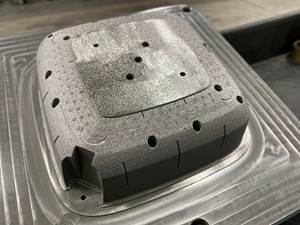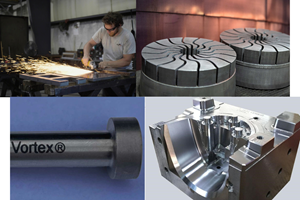Rapid Prototypes + Moldmaking = Profits
Is there an easy way to avoid the pains of making mistakes in the mold building world? Absolutely! There are three simple steps that you can implement into your moldmaking process that will increase the moldmaking power of your shop and reduce your stress.
There are three powerful steps to im-proving moldmaking power and those who have implemented these steps are well on the way to becoming the ultimate toolmakers in their industry.
The good news for you is that less than 22 percent of moldmakers actually use these steps, so the other 78 percent are willing to accept mediocrity, reduced profits, lost customers and stress-induced heart attacks. Are you one of the few or the many?
By this time in the 21st century, you should be well aware of the technologies of additive fabrication, otherwise known as rapid prototyping. These technologies have existed for more than two decades and are common tools in the product development process for most engineers and designers. What we are going to discuss is how to continuously apply these technologies to eliminate your pains as a moldmaker.
Step 1: Start at Zero
If you start with a bad design then you will begin the program in the hole or at a negative point on the scale of part creation. You have to get the design to the point where it is manufacturable. This step will eliminate bad part designs.
Have the engineer send you a model made from a RP process that uses stereolithography (SLA), selective laser sintering (SLS) or fused deposition modeling (FDM). Then with his latest design, the part can be made in a material that is closely aligned to the production material. The purpose for this request is twofold: (1) it will show that the engineer is dedicated to the success of this project and (2) with the part in hand, you will be able to easily discuss changes that would make the part more manufacturable or reduce the complexity of the tooling.
This step works great if you provide a Design For Manufacturing (DFM) report for the part before you start the project. When you recommend changing a rib width or other feature change, you can easily reference the CAD data and the RP model to make it clear to the engineer what is needed. If the engineer does not want to send a prototype then have one made for him—keeping in mind that his lack of interest in RP could also be a lack of commitment to the project. Product development is an expensive investment and taking shortcuts to save a few dollars is not always wise.
Step 2: Buy the Insurance
Tool design is next, and as we all know, even well designed parts can be complicated and hard to understand even with CAD. This step is when you “buy the insurance” to be certain you know everything about the part. This can be easily integrated into your process.
From the beginning have a RP model produced, so the tool designer can understand the geometry of the part or unique features. By leveraging the power of additive fabrication, it is easy and cost effective to get a model produced in a day that represents the detail you need. This will allow you to scale the model to any size you want, section the file and only produce what you need.
Initial responses to this approach are typically short-sighted. Why spend money on a RP model when I have this expensive CAD software? Because a RP model allows you to have a complete understanding of the part—by holding it in your hand. This provides the insurance needed to keep the project on schedule and under budget by eliminating the gotchas later in the process.
Step 3: Provide Clarity Throughout the Process
The actual execution of the project by cutting metal and making a real, functional tool to make parts is next, and this is where you can eliminate any misunderstanding. A real RP model (the one used with the tool design is fine) that travels with the project through the program allows the moldmaker to see what is expected and be able to provide valuable feedback very early in the process.
Summary
To create the right RP model, having the right process and the right material is key to providing you with the right part, so seek out companies that focus on all of the RP technologies. And remember, when having to justify the expense of RP models, focus on them as insurance—by making a small investment in RP models made from the right process, you are investing to protect your profits, your schedule and your customer’s satisfaction.
For more information from Quickparts.com call (770) 901-3200, e-mail quote@quickparts.com.
Related Content
A 3D Printing Retrospective
A personal review of the evolution of 3D printing in moldmaking throughout the past 25 years.
Read MoreMMT Chats: The Connection Between Additive Manufacturing Education and ROI
This MMT Chat continues the conversation with Action Mold and Machining, as two members of the Additive Manufacturing team dig a little deeper into AM education, AM’s return on investment and the facility and equipment requirements to implement AM properly.
Read MoreMold Materials, 3D Printing Technologies for Next-Gen Moldmaking
As moldmaking advances, so too do the materials and processes involved in their efficient production, including these latest mold materials and 3D printing technologies.
Read MoreHow to Supply Cooling to Additive Tooling
Additive tooling provides limitless options for cooling a mold’s difficult-to-cool areas.
Read MoreRead Next
Reasons to Use Fiber Lasers for Mold Cleaning
Fiber lasers offer a simplicity, speed, control and portability, minimizing mold cleaning risks.
Read MoreHow to Use Strategic Planning Tools, Data to Manage the Human Side of Business
Q&A with Marion Wells, MMT EAB member and founder of Human Asset Management.
Read MoreAre You a Moldmaker Considering 3D Printing? Consider the 3D Printing Workshop at NPE2024
Presentations will cover 3D printing for mold tooling, material innovation, product development, bridge production and full-scale, high-volume additive manufacturing.
Read More





















